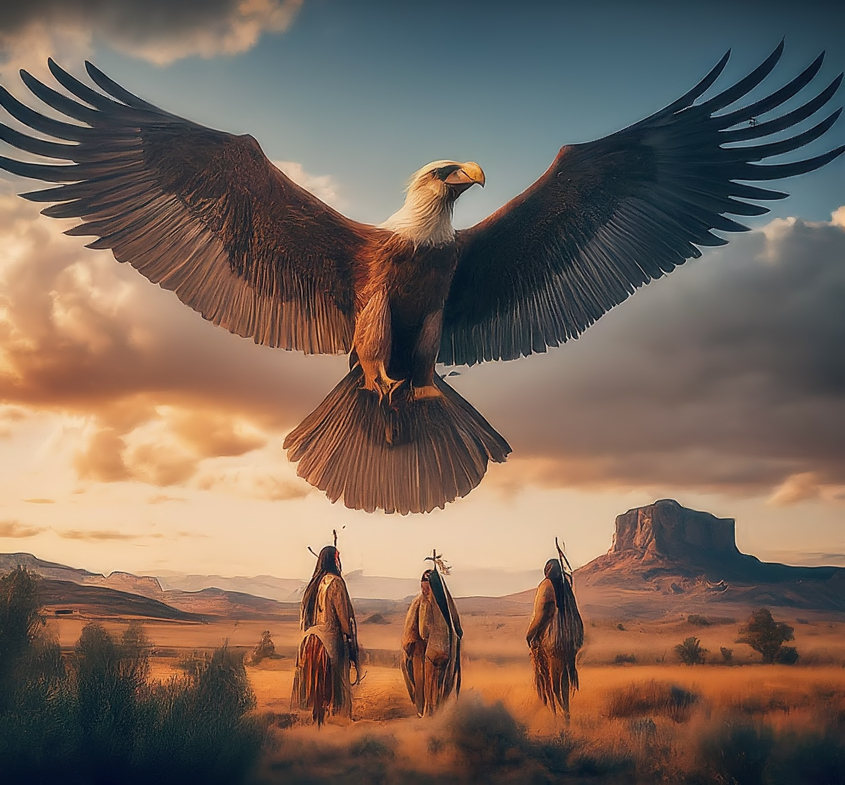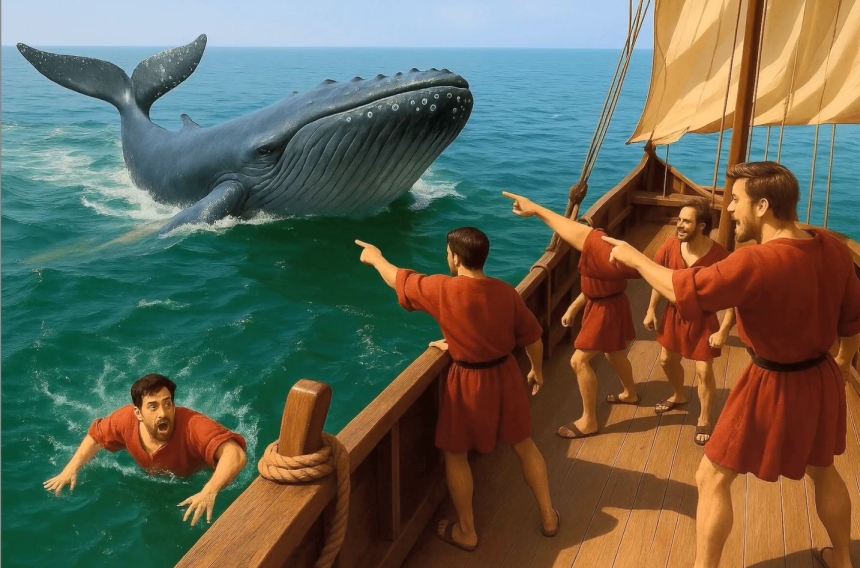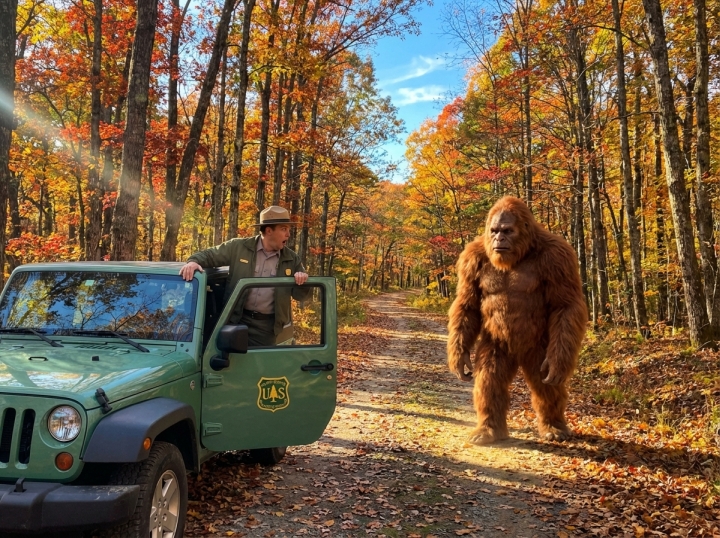In the quiet village of Togiak, nestled among the snow-capped mountains and icy rivers, residents had grown accustomed to the majesty of the wilderness. Yet nothing could have prepared them for what they were about to witness. Moses Coupchiak, a sturdy, 43-year-old heavy-equipment operator, was working the land on an October morning, his thoughts as steady as the rhythm of his tractor. As he scanned the horizon, a shape appeared in the distance, approaching with a grace and power that stole the breath from his lungs. At first, Moses thought it was one of those old-time Otter planes, a common sight in the Alaskan skies. But as the creature drew nearer, banking gently to the left, he realized with a thrill of fear and awe that it was no plane.
“It was something huge,” Moses would later recount, his voice tinged with the wonder of that moment. “The wings, wider than an Otter’s, stretched across the sky like something out of a dream.” The bird, dark and mysterious, slipped behind a hill, leaving Moses staring after it, his heart pounding. Without hesitation, he grabbed his radio, sending out a warning to the villagers—especially the children—urging them to stay indoors, away from whatever it was that had appeared over their land. The news spread quickly, reaching the ears of John Bouker, a seasoned pilot and the owner of Bristol Bay Air Service. Initially, Bouker dismissed the reports of a giant eagle as nothing more than tall tales, exaggerated in the retelling. But as fate would have it, the skies had other plans for him. While flying a routine trip into Manokotak, Bouker glanced out of his cockpit, and there, just a thousand feet away, was the creature itself.
“There it was,” Bouker would later say, still marveling at the memory. “This big…bird. Bigger than anything I’ve ever seen. The people in the plane all saw it too. Huge, just really, really big. I wouldn’t want my children out there if it came around.”
The sighting sent ripples far beyond Alaska’s borders. The news, first whispered in the quiet corners of the Anchorage Daily News, soon took flight, reaching as far as the Netherlands. Talk-show hosts across the nation, even the famously sharp-tongued David Letterman, couldn’t resist the allure of the story. The phone at Bouker’s office rang endlessly, with reporters and curious callers from London, Los Angeles, Seattle—everywhere—clamoring for more details. Bouker, overwhelmed by the sudden global interest, found himself longing for the peace and solitude that Alaska had always promised.
Scientists, too, were drawn into the mystery, though they approached it with a measured skepticism. Phil Schemf, a federal raptor specialist in Juneau, couldn’t recall anything with a wingspan of 14 feet existing in modern times. Yet the sightings were persistent, too consistent to ignore. Could it be, some speculated, that the creature was a Steller’s sea eagle, a bird known for its grand size and rare appearances in Alaska?
The Steller’s sea eagle, with its striking yellow beak, dark body, and broad white shoulders, is a magnificent sight, one that few are fortunate enough to witness. Weighing up to 20 pounds and with a wingspan that can reach eight feet, this majestic bird commands respect. Schemf acknowledged that the Steller’s eagle might well be the culprit, though even its impressive stature seemed to fall short of the legends now being whispered across the state.
Bouker, reflecting on what he had seen, was inclined to agree. “In Alaska, we see big birds, big moose, big fish,” he mused, his voice carrying the weight of one who knows the land intimately. “Things you just don’t see down south.” To him, the creature was a testament to the wild beauty and untamed spirit of Alaska, a place where the extraordinary is not just possible, but a part of everyday life.
As the days passed, the giant bird slipped back into the mists of Alaska’s endless wilderness, leaving behind a story as vast and mysterious as the land itself. Whether it was a relic of the past, a misunderstood visitor, or something else entirely, it had reminded all who heard the tale that some mysteries are best left to the skies.
The possibility of giant birds like those described by John Bouker and other witnesses continues to spark debate. Some researchers suggest that these sightings might be cases of misidentification, where large known birds are perceived as much larger due to environmental factors, such as distance, lighting, or perspective. Others propose that these sightings could be exaggerated or influenced by the psychological effects of witnessing something unusual or frightening. While the scientific consensus remains skeptical about the existence of giant birds like the one seen by John Bouker, the reports continue to capture the fascination of the public and cryptozoologists alike. Whether these creatures are remnants of a prehistoric past, cases of mistaken identity, or something else entirely, they remain a compelling part of modern folklore and a reminder of the vastness of our world and the many secrets it may still hold.
Bouker’s description of the bird bore a striking resemblance to Argentavis magnificens, a species of bird that lived during the Pleistocene epoch, around 6 million years ago. Argentavis is considered one of the largest flying birds ever known, with an estimated wingspan of up to 25 feet and standing between 5.6 to 6.6 feet tall. This bird, which was native to South America, would have been an apex predator of its time, soaring over prehistoric landscapes with ease.
The suggestion that Bouker might have seen a living Argentavis, or a similar species, is tantalizing. However, Argentavis magnificens is believed to have gone extinct long before humans ever walked the Earth. Its immense size and need for specific environmental conditions make it possible that such a creature could survive unnoticed in the modern world, particularly in the harsh and remote areas of Alaska.
Common Features in Giant Bird Sightings
Bouker’s sighting is not an isolated incident. Similar reports have been made across North America, Europe, and other parts of the world. These sightings often share certain common characteristics:
Enormous Wingspans: Witnesses consistently describe wingspans far larger than any known bird species, ranging from 10 to 25 feet. Such dimensions surpass those of even the largest modern birds, like the Andean condor or the albatross.
Dark or Black Plumage: The birds are frequently described as having dark, often black feathers. This dark coloration adds to the ominous presence of these creatures, contributing to their mythical status.
Silent Flight: One of the most eerie aspects of these sightings is the reports of silence as the birds fly. Despite their massive size, they are often described as moving through the air without making any noise, defying expectations for a creature of their magnitude.
The possibility of giant birds like those described by John Bouker and other witnesses continues to spark debate. Some researchers suggest that these sightings might be cases of misidentification, where large known birds are perceived as much larger due to environmental factors, such as distance, lighting, or perspective. Others propose that these sightings could be exaggerated or influenced by the psychological effects of witnessing something unusual or frightening.
Despite the fascination and intrigue surrounding sightings of enormous flying raptors, the scientific community remains skeptical. The lack of physical evidence, such as bones, feathers, or nests, is a significant hurdle in validating these claims. Most birds leave behind some form of tangible evidence, and creatures of the purported size would likely leave noticeable traces in their habitat.
Moreover, modern technology, including high-resolution cameras, drones, and satellite imagery, has yet to capture definitive proof of these creatures. Skeptics argue that with so many eyes on the sky and the increasing capability to document wildlife, the absence of credible evidence points to other explanations for these sightings.
However, there are times when a very well known creature, that is very big to begin with, turns out to be much larger than the known species is, because this particular individual animal suffers from giantism, a medical condition nearly always caused by an adenoma, a tumor of the pituitary gland. The pituitary gland tumor cells secrete too much growth hormone (GH), leading to many changes in the body. Consider these examples: the largest squid ever found measured 59 feet in length and weighed nearly a ton, according to National Geographic Magazine. The common size for a giant squid is 43 feet long. The largest octopus ever found measured a tentacle span of 30 feet across, according to National Geographic Magazine and The Guinness Book of World Records.
There are animals that just grew by genetics; biology to immense sizes without a pituitary gland hormone mis-function. Consider such examples. The average giant octopus is typically 16 feet long. There is the natural species of the giant crab that has a leg span of over 13 feet across. Crabs seen on beaches are called sand crabs or mole crabs. These male crabs are usually only a little under an inch tall while the females of such crabs are usually up to two inches tall. The average size for a beaver is from 2 feet 11 inches to 3 feet 3 inches long. The biggest beaver ever found, in 1921 in Wisconsin was from the Iron River and was twice as big as the average sized beaver. In the Pleistocene Age, the largest known rodent in North America was the giant beaver, a naturally occurring animal species whose average approximate length was 6.2 feet to 7.2 feet in length. During the age of the dinosaurs, the average sea scorpion and reached total lengths of over 8 feet. The average scorpion today is only about 2.5 inches. The ancient giant ground sloth grew to the average size of about 20 feet long. The typical sloth of today grows only to about 2.5 feet in length. A few other animals that were giants in dinosaur times included rats as large as bulls, the megaladan, a shark much, much bigger than today’s sharks, and salamanders 5 feet or 6 feet long.
The phenomenon of mysterious giant flying birds straddles the line between myth and reality. Historical accounts and modern sightings keep the legend alive, fueling speculation and curiosity. Whether these reports are rooted in mis-identification, surviving prehistoric species, undiscovered modern species, or psychological factors, they continue to captivate the human imagination. Until definitive evidence emerges, the gargantuan sky birds will remain an enigmatic chapter in the ongoing exploration of our natural world. But, of course, there are the existing birds of today that have undergone pituitary gland deviation that produced giantism, and this physical condition, combined with strong over estimations in size, can produce sightings of mysterious colossal in flight birds.





